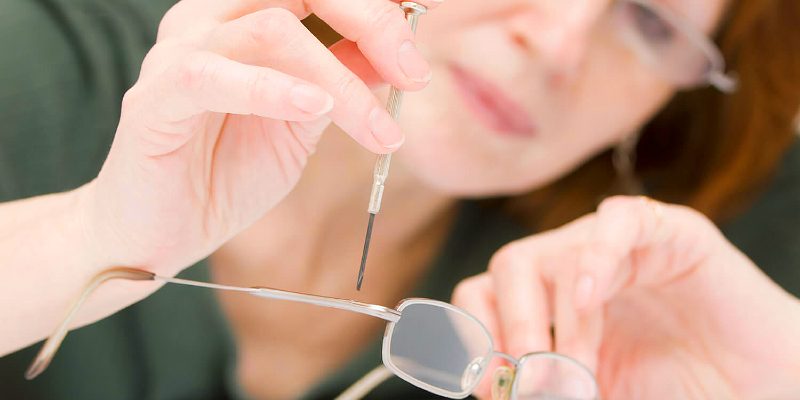Outlines how to tighten glasses, replace nose pads, change temple ends and steps to adjust your glasses for the perfect fit to your face.
Fin dmore repair guides, tips and advice
It happens often that the arm or temple of glasses can become loose, or even become detached entirely. Below we will illustrate the steps for how to tighten glasses, and several other repairs and adjustments you can make yourself with just a few simple tools and a bit of care.
How to tighten glasses at the temple
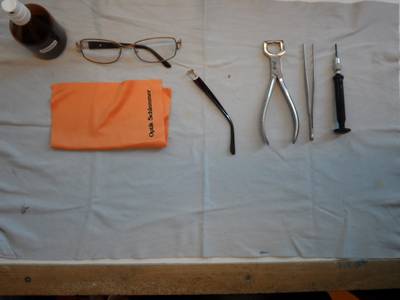
How to tighten glasses: Step 1: Have the necessary utensils ready.
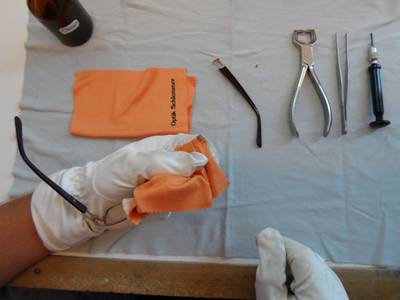
Step 2: Put a cloth around the hinge to protect the glass.
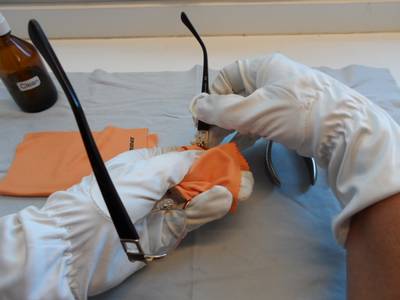
Step 3: Place the bracket hinge rollers in the hinge.
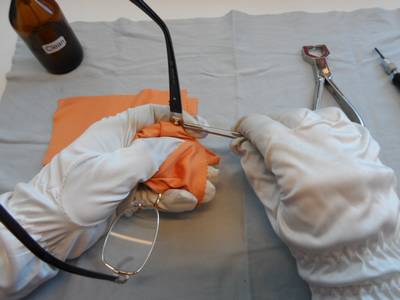
Step 4: Insert the screw into the thread with tweezers or fingernail.
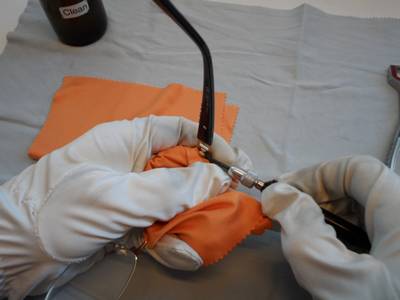
Step 5: Tighten the screw with a suitable screwdriver.
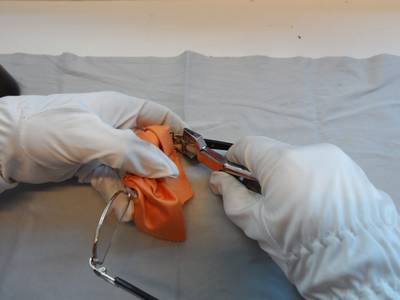
Step 6: Punch the end of the screw with a center punch, if you have one, so that it does not come loose by itself.
Easy cleaning of glasses
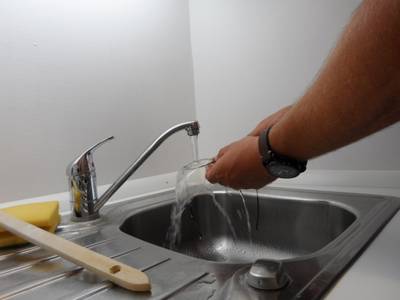
Step 1: Rinse the glasses once under lukewarm water.
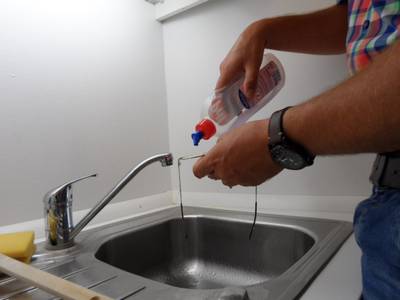
Step 2: Then put a drop of detergent on each glass.
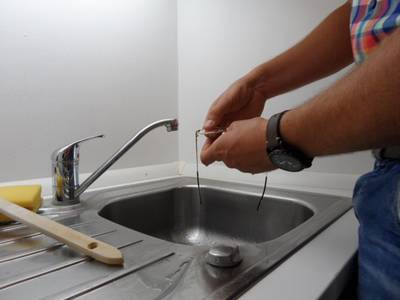
Step 3: Rub the glasses well with the detergent between your fingers.
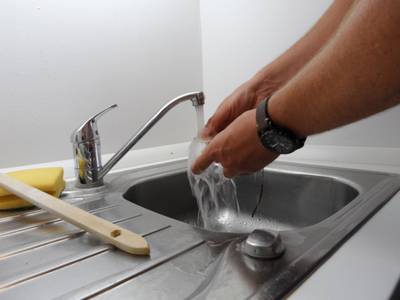
Step 4: Carefully rinse off the front and back of the dish with lukewarm water.
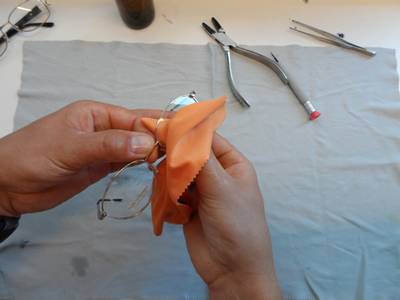
Step 5: Wipe the entire glasses dry with a clean microfiber cloth.
Exchange temple ends on glasses arms
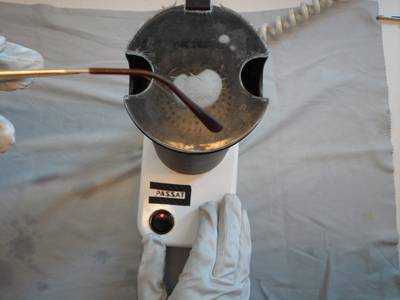
Step 1: Gently heat the old temple ends over steam or a warmer, and peel them off.
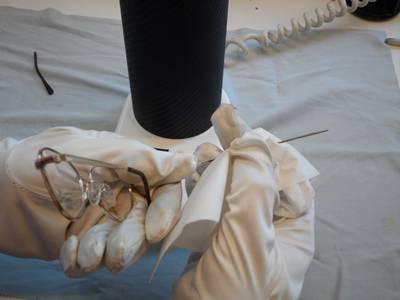
Step 2: Bend the metal core of the bracket straight and clean it thoroughly.
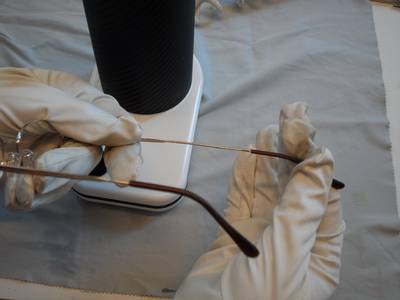
Step 3: Slide the new temple end onto the metal. Possibly heat the plastic slightly and only briefly.
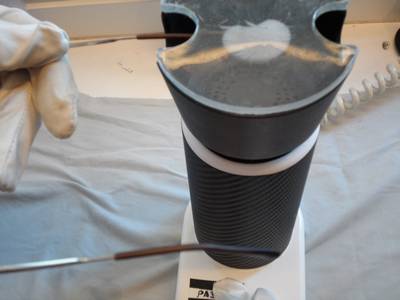
Step 4: When the temple end is in place, gently heat the arm at the temple end.
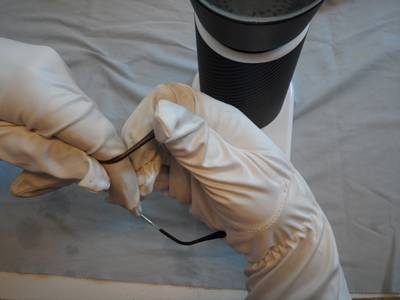
Step 5: Then bend the temple again so that the glasses fit behind the ears.
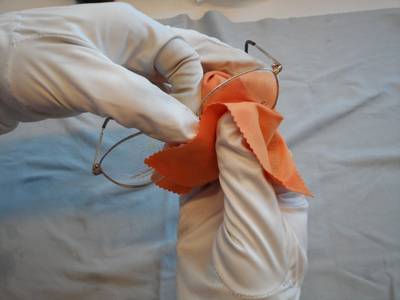
Step 6: Finally, clean all of the glasses.
Change nose pads that are screwed on
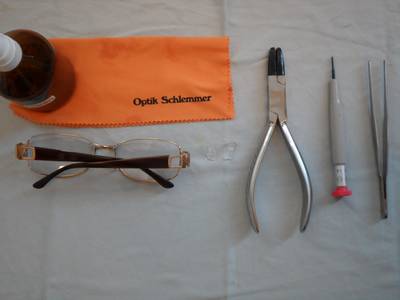
Step 1: Have tools, utensils and suitable pads ready.
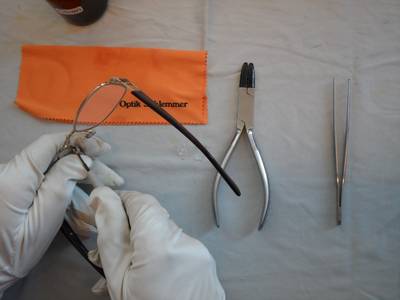
Step 2: Unscrew the old pads, use a suitable screwdriver and protect the glass with the glove.
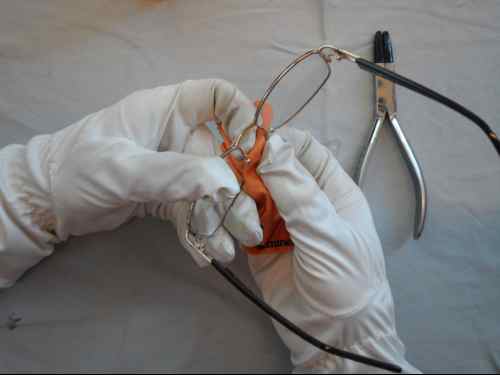
Step 3: clean the metal pad holder.
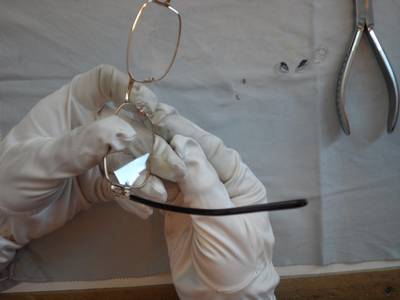
Step 4: Insert the new pad into the pad holder.
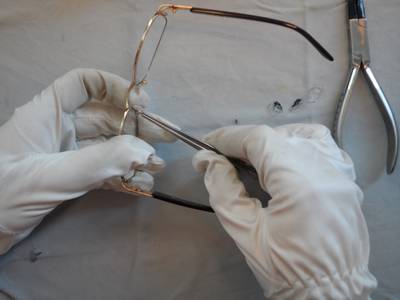
Step 5: Use screw tweezers to insert the screw into the opening of the pad holder.
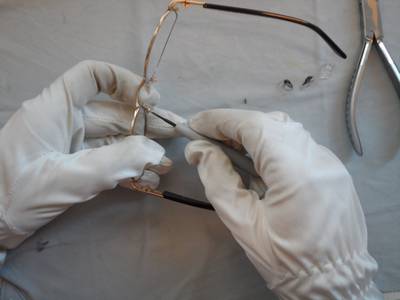
Step 6: Screw in the screw with a suitable screwdriver.
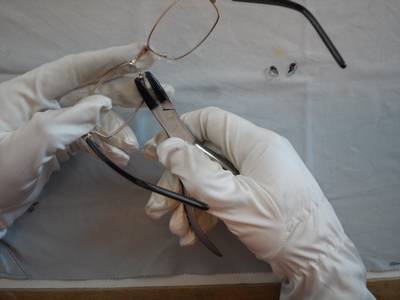
Step 7: Align the pod holder with pliers if it is bent.
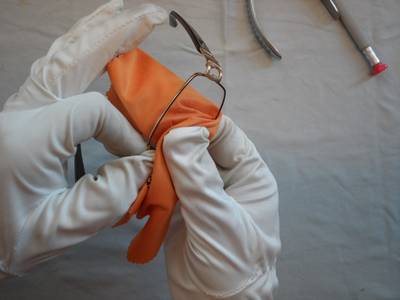
Step 8: clean the entire glasses.
Replace nose pads that are clipped on
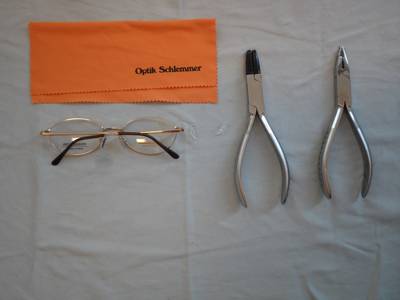
Step 1: Have tools, utensils and suitable pads ready.
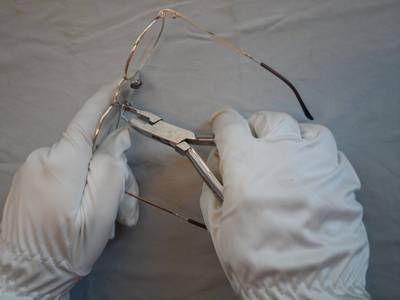
Step 2: Loosen old pads GENTLY with pliers.

Step 3: clean the metal pad holder.
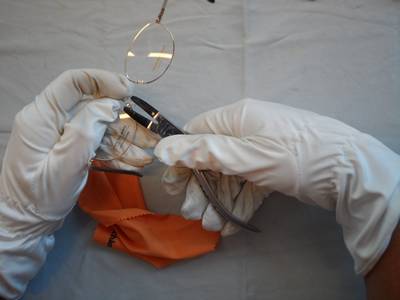
Step 4: Click on the new pad with the double jaw pliers.
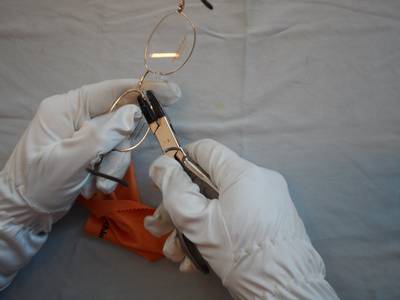
Step 5: Align the pod holder with pliers if it has been bent.
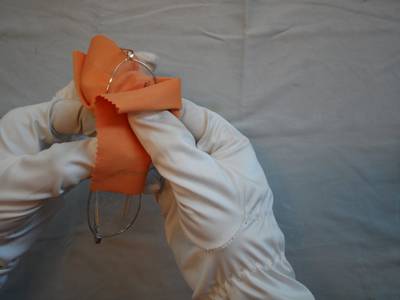
Step 6: Finally, clean the entire glasses.
How to tighten glasses and adjust for perfect fit
Do your glasses pinch behind your ears, keep slipping off your nose or sit crooked? Now is the time to readjust your visual aid. However, this does not necessarily require a visit to the optician – with a little skill and the right tools, you can make minor adjustments yourself.
We explain step by step how you can easily adjust your glasses correctly yourself. This knowledge pays off, especially in urgent cases, on Sundays and public holidays or on the go. Find out here when a visit to the optician is unavoidable and how they can help you with the smallest screws and new nasal plates.
Do my glasses fit correctly?
Don’t worry, it is quite normal for glasses to become a little uncomfortable over time and to fit poorly. Daily wear, for example, can change the width of the glasses very quickly – and then the glasses slip even with the smallest movements. The effects of poorly fitting glasses should not be underestimated. The constant pushing up of the glasses is annoying, not to mention the pain in the ears and temples. Badly fitted glasses often cannot fulfill their actual main task, namely to ensure optimal quality of vision. It doesn’t help that the corrective strength of the lenses is optimally tailored to you.
To check the fit of your glasses, you don’t even need a mirror at first. Here are some things to check out when you wear your glasses every day:
- Your glasses don’t put any pressure on your temples.
- You only feel a slight pull on the temples behind your ears and they rest against the auricle.
- You don’t feel any significant or uncomfortable weight on your nose.
- The glasses sit horizontally on your nose and do not hang down on one side.
- Your glasses won’t slip when you tilt your head down.
For example, if the pull behind the ears is too strong, the temples are usually too short. This means that the temples move up behind the ears over time and the glasses slip on the nose. The last thing you can check to see whether your glasses are properly seated is by looking in the mirror: is the center of your glasses positioned correctly over your pupils? If not, it’s time to correct.
What to look for when buying glasses
Tip: Make sure that the glasses fit well when you buy them. Changes in the nose area are particularly difficult to implement with plastic frames. Metal frames, on the other hand, usually have exchangeable nose pads, the position and shape of which can be used to align the glasses.
Basically: The frame should end with the upper edge below the eyebrows and above the eye crease. So it does not restrict the field of vision. Balanced proportions are ensured if the glasses frame are not significantly wider than your face and you can see through the lenses as centrally as possible. Of course, there is a certain leeway with these rules of thumb, which depends on the shape of the glasses, the vision correction required and the use of the glasses.
For athletes, the requirements are a little higher. After all, the glasses shouldn’t slip or get lost despite quick movements and sweat. You can, for example, retrofit your glasses with special temple covers made of silicone, which helps prevent the glasses from slipping.
How to tighten and adjust glasses: Step by step to the perfect fit
Before you begin, have the correct tools ready. Needle-nose pliers and a small screwdriver are particularly helpful. To prevent the glasses frame from being scratched or damaged, it is better to use pliers with padded tips. Alternatively, you can use adhesive tape to protect your glasses from scratches and pressure marks in the appropriate places. You will also need a flat work surface for the setting process itself.
Since glasses can press in different places or sit incorrectly, there are different ways to adjust the glasses.
If the glasses are too loose
If your glasses are loose and often slide forward, the problem is with the width of the glasses. The best way to remedy this is to tighten the screws in the bracket joints as we outlined above in the section on how to tighten glasses. What to Avoid: Changing the bend of the bridge of the nose, because the axis on which the lenses lie should not be changed.
You can also adjust the temples of your glasses to the width of your face by carefully bending them with needle-nose pliers. Do this slowly and check the result often so that the frame does not break.
If the glasses pinch behind the ear
If the temple ends press or protrude behind the ear, the same procedure as for correcting the glasses width will help. Plastic hangers should first be heated with a hairdryer or in a water bath so that they can be bent and adjusted with the pliers. Be particularly careful here too and do not work with excessively high temperatures. If the temples are too tight or too loose, you can bend the curve up or down accordingly.
If the glasses sit too high or too low
If your glasses sit too high or too low on your nose, adjustments to the bridge and the nasal plates (also known as nose pads) can help. If you tighten the nasal plates, the glasses move upwards. On the other hand, if you move them further, your visual aid will slide downwards. It is best to adjust the nasal platelets individually for each side, so you can also make sure that they are correctly placed on the bridge of the nose and not press.
If the glasses are crooked
Pay attention to the symmetry between the two nasal plates to allow the glasses to fit straight. This simple test also helps: Do both temples evenly touch the surface when you put your glasses down with the temples down? If a bracket sticks upwards, you can carefully bend it into the correct position with needle-nose pliers.
In these cases, an optician can help
Glasses can be quite sensitive and often require tact. If you are unsure where you can bend or you don’t have the right tool, we recommend going to the optician. He not only has the right equipment, but also the necessary material and can replace small screws or insert new nasal plates. The latter in particular often requires advice, as nasal plates come in different sizes and degrees of softness. The way it is attached to the glasses also differs from frame to frame. Your optician is familiar with the various options such as screw and plug-in sockets.

